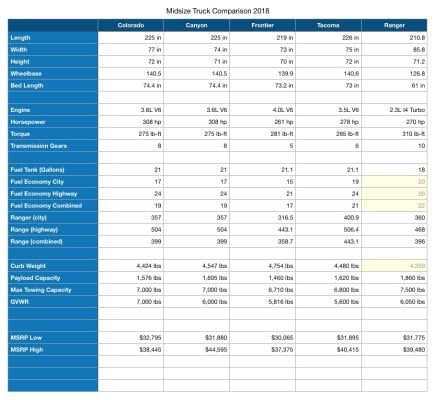Hi,
I appreciate all the great insights I gained from WTW forums. This is my foray into the world of pickups and camper shells and I am struggling. I am selecting/matching a pickup and a slide-in, pop-up camper shell. My preference is a small 4x4 pickup (Frontier, Tacoma, Colorado, etc.). I am looking at the All-Terrain Bobcat shell which I’m told by the manufacturer is 530 lb. dry wt. (this seems low so I’m guessing it does not include tie-downs, jack brackets, etc.). My comfort needs are best described as “Spartan”. I am comfortable sleeping in a tent at temps well below freezing. Consequently, I will have very few amenities and a very light build out.
I have been looking very closely at truck payloads, curb wt., GVWR, and GAWR. I simply can’t make even the lightest camper work with the biggest payload 4x4 small truck. I am treating manufacturer payload limits as absolute, not recommendations. I’m sure there is a healthy F.S. but I’m sticking to the spec (BTW, I’m going by the payload capacity on the inside door sticker, not the spec sheet, which is not always accurate).
From this process, I’ve drawn 2 conclusions:
(Please note, I am NOT talking about WTW forum readers. This is a much more sophisticated, informed crowd than the average camper owner.)
1) People (again, not WTW forum readers) seem very cavalier about keeping payloads within spec (and I’m just talking about camper shells, not winches, bumpers, awnings, etc., beefed up suspension, etc).
2) I will never by a used pickup that had a camper on it b/c of #1 above.
My thinking is that overloaded trucks present 2 safety issues – poor drivability and excessive wear & tear on components. It seems popular to mitigate drivability issues by beefing up the suspension but that won’t help and will probably exacerbate the wear and tear issue (e.g., adding spring leafs adds weight). The wear and tear problem is not just a maintenance cost issue, it’s also a matter of safety b/c I don’t want to breakdown in a hostile environment with no help readily available.
There are a lot on unknowns but I’ve been adding up my payload ounces (my friend always says to “watch the ounces and the pounds take care of themselves”). I’m estimating for short weekend trips with gear, I will be around 1350 lb. This is doable with certain small 4x4 trucks, in fact, my friends safely and successfully hit this mark. However, I’d like to have at least a 200 lb. buffer b/c my prospective passengers have a 125 wt. variance, I’d like to occasionally throw on some bikes or kayaks, I don’t always meet my dietary goals, etc. ;-)
So, should I just resign to driving a bigger pick-up or is there hope?
[SIZE=11pt]Thanks.[/SIZE]
I appreciate all the great insights I gained from WTW forums. This is my foray into the world of pickups and camper shells and I am struggling. I am selecting/matching a pickup and a slide-in, pop-up camper shell. My preference is a small 4x4 pickup (Frontier, Tacoma, Colorado, etc.). I am looking at the All-Terrain Bobcat shell which I’m told by the manufacturer is 530 lb. dry wt. (this seems low so I’m guessing it does not include tie-downs, jack brackets, etc.). My comfort needs are best described as “Spartan”. I am comfortable sleeping in a tent at temps well below freezing. Consequently, I will have very few amenities and a very light build out.
I have been looking very closely at truck payloads, curb wt., GVWR, and GAWR. I simply can’t make even the lightest camper work with the biggest payload 4x4 small truck. I am treating manufacturer payload limits as absolute, not recommendations. I’m sure there is a healthy F.S. but I’m sticking to the spec (BTW, I’m going by the payload capacity on the inside door sticker, not the spec sheet, which is not always accurate).
From this process, I’ve drawn 2 conclusions:
(Please note, I am NOT talking about WTW forum readers. This is a much more sophisticated, informed crowd than the average camper owner.)
1) People (again, not WTW forum readers) seem very cavalier about keeping payloads within spec (and I’m just talking about camper shells, not winches, bumpers, awnings, etc., beefed up suspension, etc).
2) I will never by a used pickup that had a camper on it b/c of #1 above.
My thinking is that overloaded trucks present 2 safety issues – poor drivability and excessive wear & tear on components. It seems popular to mitigate drivability issues by beefing up the suspension but that won’t help and will probably exacerbate the wear and tear issue (e.g., adding spring leafs adds weight). The wear and tear problem is not just a maintenance cost issue, it’s also a matter of safety b/c I don’t want to breakdown in a hostile environment with no help readily available.
There are a lot on unknowns but I’ve been adding up my payload ounces (my friend always says to “watch the ounces and the pounds take care of themselves”). I’m estimating for short weekend trips with gear, I will be around 1350 lb. This is doable with certain small 4x4 trucks, in fact, my friends safely and successfully hit this mark. However, I’d like to have at least a 200 lb. buffer b/c my prospective passengers have a 125 wt. variance, I’d like to occasionally throw on some bikes or kayaks, I don’t always meet my dietary goals, etc. ;-)
So, should I just resign to driving a bigger pick-up or is there hope?
[SIZE=11pt]Thanks.[/SIZE]

